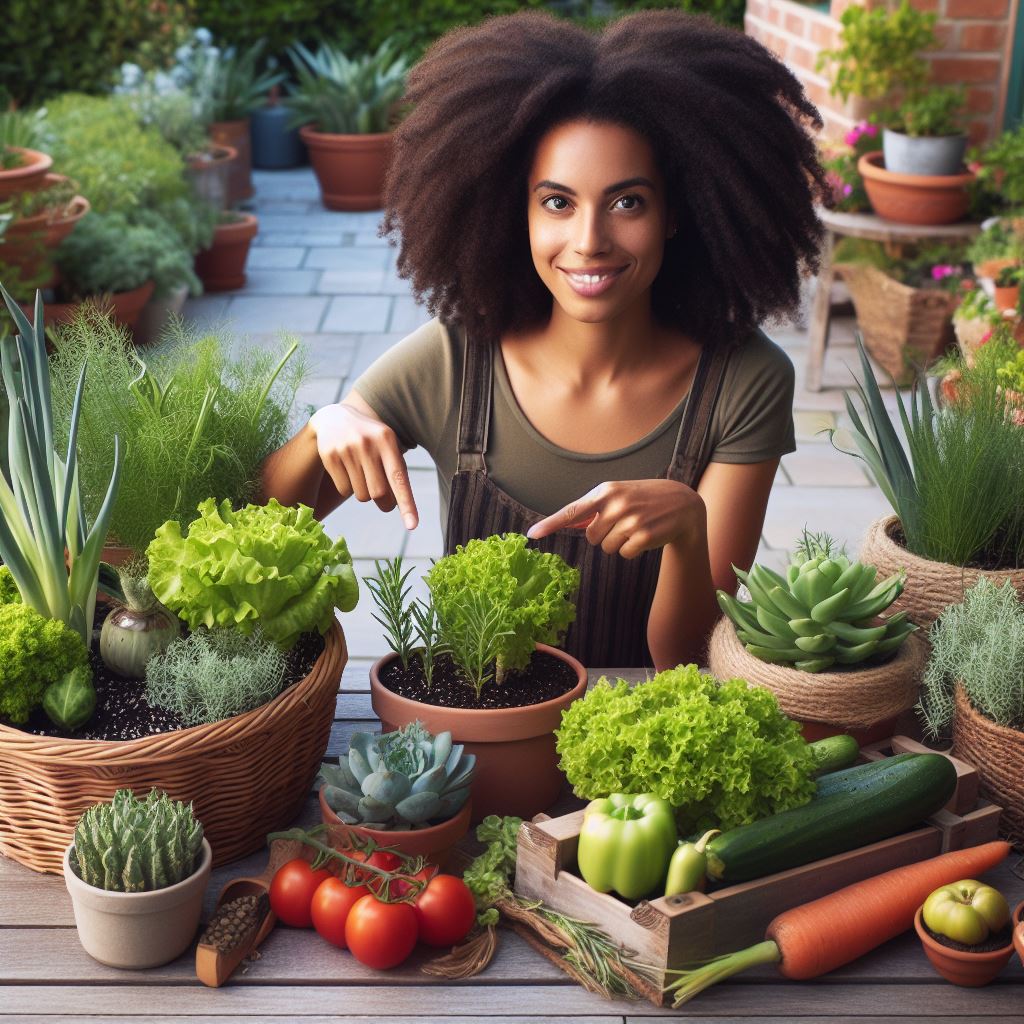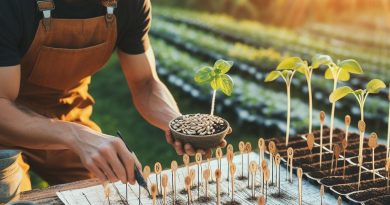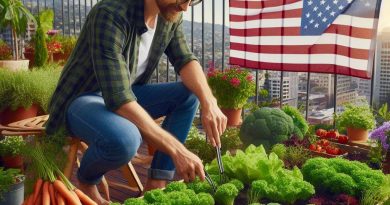Container Gardening: Veggies on Your Patio
Last Updated on February 28, 2024
Introduction
Container gardening offers a versatile and convenient way to grow vegetables right on your patio.
Definition of container gardening
- Growing plants in containers instead of traditional garden beds.
- Suitable for small spaces like patios, balconies, or even windowsills.
Growing vegetables on patios
- Utilizing containers to cultivate a variety of vegetables.
- Perfect for urban dwellers or those with limited outdoor space.
Benefits of container gardening
- Flexibility to move plants for optimal sunlight and space.
- Control over soil quality and drainage for healthier plants.
- Accessibility for those with physical limitations or mobility issues.
With container gardening, you can enjoy the satisfaction of harvesting fresh vegetables right outside your door, no matter how small your outdoor space may be.
Choosing the Right Containers
Choosing the right containers for your vegetable garden is essential for successful container gardening.
Whether you have limited space or simply want to bring your garden closer to your living space, selecting the right containers can make all the difference in the growth and productivity of your plants.
Size and depth considerations
Firstly, consider the size and depth of the containers.
Different vegetables have distinct root system requirements, so choose containers that can accommodate their needs.
Deep-rooted plants like tomatoes and peppers will need larger and deeper containers, while shallow-rooted plants like lettuce and herbs can thrive in smaller and shallower containers.
Material options (e.g., clay, plastic, fabric)
Secondly, take into account the material options available.
Clay pots are popular for their natural appearance and good airflow, but they can dry out quickly.
Plastic pots, on the other hand, are lightweight, retain moisture well, and are often more affordable.
Fabric pots are a newer option that promotes better root aeration, preventing overwatering and ensuring healthier plants.
Drainage requirements
Next, consider the drainage requirements.
Proper drainage is crucial for preventing waterlogging and keeping the roots healthy.
Ensure that the containers you choose have sufficient drainage holes, allowing excess water to escape freely.
Accessibility and mobility factors
Last but not least, accessibility and mobility should be considered.
If you have limited space or plan to move your containers frequently, lightweight options such as plastic or fabric will be more convenient.
Additionally, containers at a comfortable height will make gardening more enjoyable and prevent unnecessary strain on your back.
To enhance mobility, especially for larger patio or balcony areas, consider using wheeled containers.
By carefully considering the size, material, drainage, accessibility, and mobility factors when choosing your containers, you will set a solid foundation for your container gardening success.
Remember, the right containers support healthy root growth and provide the necessary conditions for your vegetables to flourish on your patio or balcony.
Read: Micro Farming: Grow More in Less Space
Selecting Suitable Vegetables for Container Gardening
Compact and dwarf varieties
When selecting vegetables for container gardening, it is important to choose varieties that are well-suited for small spaces.
Compact and dwarf varieties are excellent options as they take up less room and still produce a bountiful harvest.
Vegetables with shallow root systems
Vegetables with shallow root systems are also ideal for container gardens.
They can establish themselves in the limited soil space and thrive in containers.
Examples include radishes, green onions, and certain salad greens.
Recommended vegetables for patio gardening
If you are gardening on a patio, there are specific vegetables that are highly recommended for this setup.
Tomatoes, especially determinate varieties bred for containers, are a popular choice.
They can be grown in pots or hanging baskets and provide a plentiful harvest.
Peppers, both sweet and hot varieties, also do well in containers.
Look for compact varieties that will thrive in the limited space. With proper care, you can enjoy fresh peppers throughout the growing season.
Lettuce and salad greens are excellent choices for patio gardening.
Not only do they have shallow root systems, but you can also harvest them as baby greens or mature heads.
Take advantage of their quick growth and enjoy fresh salads all season long.
Herbs are another great option for container gardening. Basil, thyme, and mint are just a few examples.
They can be easily grown in pots and provide fresh flavors for your culinary creations.
Consider planting them together in a mixed herb container for a convenient herb garden.
With careful selection and proper care, you can create a thriving container garden on your patio, filled with a variety of delicious vegetables to enjoy throughout the season.
Read: Easy Herbs for Window Gardening Success
Preparing the Containers and Potting Mix
Achieving success with container gardening begins with properly preparing the containers and potting mix.
These steps are essential for providing an optimal environment for your vegetable plants to thrive.
Cleaning and sanitizing containers
Before planting, it’s crucial to clean and sanitize your containers to prevent the spread of diseases and pests.
Start by scrubbing them with warm, soapy water and rinsing thoroughly.
Next, soak the containers in a solution of one part bleach to nine parts water for 10 minutes.
Rinse again to remove any remaining bleach, ensuring a clean and sterilized container.
Providing proper drainage
Ensuring proper drainage is vital for container gardening.
To avoid waterlogged soil, containers should have drainage holes at the bottom. Use a drill or hammer and nail to create these holes.
Elevating the containers slightly, using bricks or pot feet, can also promote drainage and prevent water from pooling around the plant roots.
Selecting a quality potting mix or DIY options
Choosing the right potting mix is essential for container gardening success.
Look for a high-quality commercial mix specifically formulated for containers and vegetables.
If you prefer a DIY approach, you can create your own potting mix by combining equal parts of compost, peat moss, and perlite or vermiculite.
This mixture provides nutrients, moisture retention, and good drainage.
Importance of adding organic matter and fertilizer
Adding organic matter to your potting mix is crucial for providing essential nutrients to your vegetable plants.
Quality compost, well-rotted manure, or worm castings are excellent choices.
Additionally, incorporating a slow-release or organic fertilizer into the potting mix will provide a steady supply of nutrients throughout the growing season, ensuring healthy and abundant vegetable yields.
By following these steps and preparing your containers and potting mix properly, you are setting the foundation for successful container gardening.
In the next section, we will discuss the selection of suitable vegetable plants for your patio containers.
Read: Grow Herbs on Your Porch: Simple Techniques

Planting and Caring for Container Vegetables
Seed starting versus transplanting seedlings
Starting seeds indoors gives you more control over the growing process.
Transplanting seedlings is a quicker option if you’re short on time.
Planting depth and spacing guidelines
Follow the seed packet or plant label instructions for specific planting depths.
Proper spacing ensures that each plant has enough room to grow and access sunlight.
Ideal watering and moisture levels
Water container vegetables when the top inch of soil feels dry to the touch.
Ensure adequate drainage to prevent waterlogging and root rot.
Fertilizing and feeding schedule
Use a balanced organic fertilizer according to the plant’s needs and package instructions.
Feed the vegetables every two weeks during their growing season.
Staking or supporting plants, if necessary
Some plants, like tomatoes, may require staking or support to prevent them from toppling over.
Use bamboo stakes, trellises, or cages to provide support as the plants grow.
Regular pruning and pest/disease management
Prune container vegetables to remove dead or diseased plant parts and promote airflow.
Monitor for pests and diseases regularly and take appropriate action to prevent or control them.
Proper care and maintenance are essential for successful container vegetable gardening.
Whether you choose to start seeds or transplant seedlings, always follow the guidelines for planting depth and spacing.
Water your plants when the soil is dry and ensure proper drainage.
Fertilize your vegetables regularly and provide support to plants that need it.
Additionally, remember to prune your plants and stay vigilant against pests and diseases.
By following these steps, you can enjoy a thriving container vegetable garden on your patio.
Read: Urban Veggie Gardens: Small Spaces, Big Yields
Tips for Maximizing Yield and Space Efficiency
Companion planting techniques
- Pair compatible plants together to optimize growth and deter pests.
- Plant marigolds alongside vegetables to repel insects and attract beneficial pollinators.
- Consider planting herbs like basil, mint, or parsley to deter pests and enhance the flavor of nearby vegetables.
Succession planting
- Extend your harvest season by planting crops in multiple stages.
- Once one crop is harvested, replant that space with a new crop.
- Select vegetables with varying maturity dates to ensure a continuous supply.
Vertical gardening options
- Grow vining crops, such as cucumbers or beans, on trellises or stakes.
- Utilize vertical space by using hanging planters or wall-mounted containers.
- Choose compact varieties of plants that naturally grow upward, such as cherry tomatoes or mini peppers.
Utilizing hanging baskets or trellises
- Hang baskets from the ceiling or hooks on a patio fence.
- Plant trailing or cascading vegetables like strawberries or trailing tomatoes.
- Incorporate hanging trellises to grow climbing vegetables like peas or vine tomatoes.
Balcony-specific gardening strategies
- Opt for dwarf or compact varieties of vegetables that can thrive in smaller containers.
- Use window boxes or railing planters to maximize space.
- Place plants strategically to ensure they receive adequate sunlight and wind protection.
In essence, container gardening on your patio provides an excellent opportunity to grow fresh vegetables even in limited space.
By following these tips for maximizing yield and space efficiency, you can enjoy a bountiful harvest and make the most of your container garden.
Harvesting and Enjoying Your Patio Vegetables
Identifying harvest-ready vegetables
- Observe the color, size, and texture of the vegetables to determine if they are ready to be harvested.
- Leafy greens are typically harvested when they reach their desired size, usually around 4-6 weeks after planting.
- Root crops like carrots and radishes are ready when their tops protrude from the soil and have reached the desired thickness.
- Fruit-bearing vegetables, such as tomatoes and peppers, should be harvested when they are firm, fully colored, and slightly soft to touch.
- Regularly check your vegetables for any signs of overripeness, such as wilting or discoloration.
Gentle harvesting techniques
- Use sharp garden scissors or pruning shears to carefully cut leafy vegetables, avoiding damage to nearby plants.
- Gently pull on the base of the leafy greens to remove them from the soil without disrupting the roots.
- For root crops, use a garden fork or your hands to loosen the soil around the vegetables before gently pulling them out.
- For fruits like tomatoes, gently twist and lift the stem, ensuring you don’t damage the plant or the surrounding fruits.
- Handle all harvested vegetables with care to prevent bruising or other damage.
Storing and preserving surplus produce
- Store freshly harvested vegetables in a cool place, such as a refrigerator or a root cellar, to extend their shelf life.
- Clean and dry the vegetables before storing them to prevent rotting or mold formation.
- If you have excess produce, consider preserving them through canning, pickling, or freezing for later use.
- Follow proper food preservation techniques to ensure the quality and safety of your preserved vegetables.
- Share the surplus produce with friends, family, or neighbors to avoid any wastage.
Cooking and enjoying homegrown vegetables
- Wash the harvested vegetables thoroughly before using them in your favorite recipes.
- Try simple preparations to highlight the freshness and flavor of the homegrown vegetables.
- Steam or sauté leafy greens like spinach or kale with some garlic and olive oil for a nutritious side dish.
- Roast root vegetables, such as carrots and beets, to bring out their natural sweetness and caramelization.
- Experiment with different recipes and cooking methods to make the most of your homegrown bounty and enjoy the fruits of your labor!
Now that you’ve successfully grown and harvested your own vegetables on your patio, it’s time to savor the rewards of your hard work.
By identifying when to harvest, using gentle techniques, properly storing surplus produce, and preparing delicious meals, you can fully enjoy the satisfaction of growing your own food.
Embrace the joy of container gardening and taste the difference of homegrown vegetables!
Conclusion
Container gardening on your patio offers numerous benefits, making it an attractive option for urban dwellers with limited space.
By embracing this gardening method, you can enjoy fresh vegetables right at your doorstep while adding greenery and beauty to your outdoor space.
One of the key advantages of container gardening is its versatility.
You can grow a wide variety of vegetables, herbs, and even fruits in containers, allowing you to diversify your harvest and experiment with different crops.
Moreover, container gardening is accessible to beginners and seasoned gardeners alike.
You don’t need a large yard or extensive gardening experience to start growing your own vegetables.
With just a few containers, potting soil, and seeds or seedlings, you can create a thriving garden on your patio.
Additionally, container gardening offers the flexibility to move your plants around as needed, ensuring optimal sunlight exposure and protection from harsh weather conditions.
This adaptability is particularly beneficial for urban gardeners who may need to maximize limited outdoor space or adjust their garden layout based on seasonal changes.
Overall, container gardening on your patio provides a convenient, sustainable, and enjoyable way to grow your own food and connect with nature, even in the heart of the city.
So, roll up your sleeves, grab some containers, and start your patio garden adventure today!


